Data Communication and Networks - Desklib
VerifiedAdded on 2023/06/07
|9
|1332
|85
AI Summary
This article discusses hybrid topology, advantages and disadvantages, server-based computers, subnetting steps, and more in Data Communication and Networks. It also includes a scenario and subnet definition. The subject is Data Communication and Networks, and the course code and college/university are not mentioned.
Contribute Materials
Your contribution can guide someone’s learning journey. Share your
documents today.
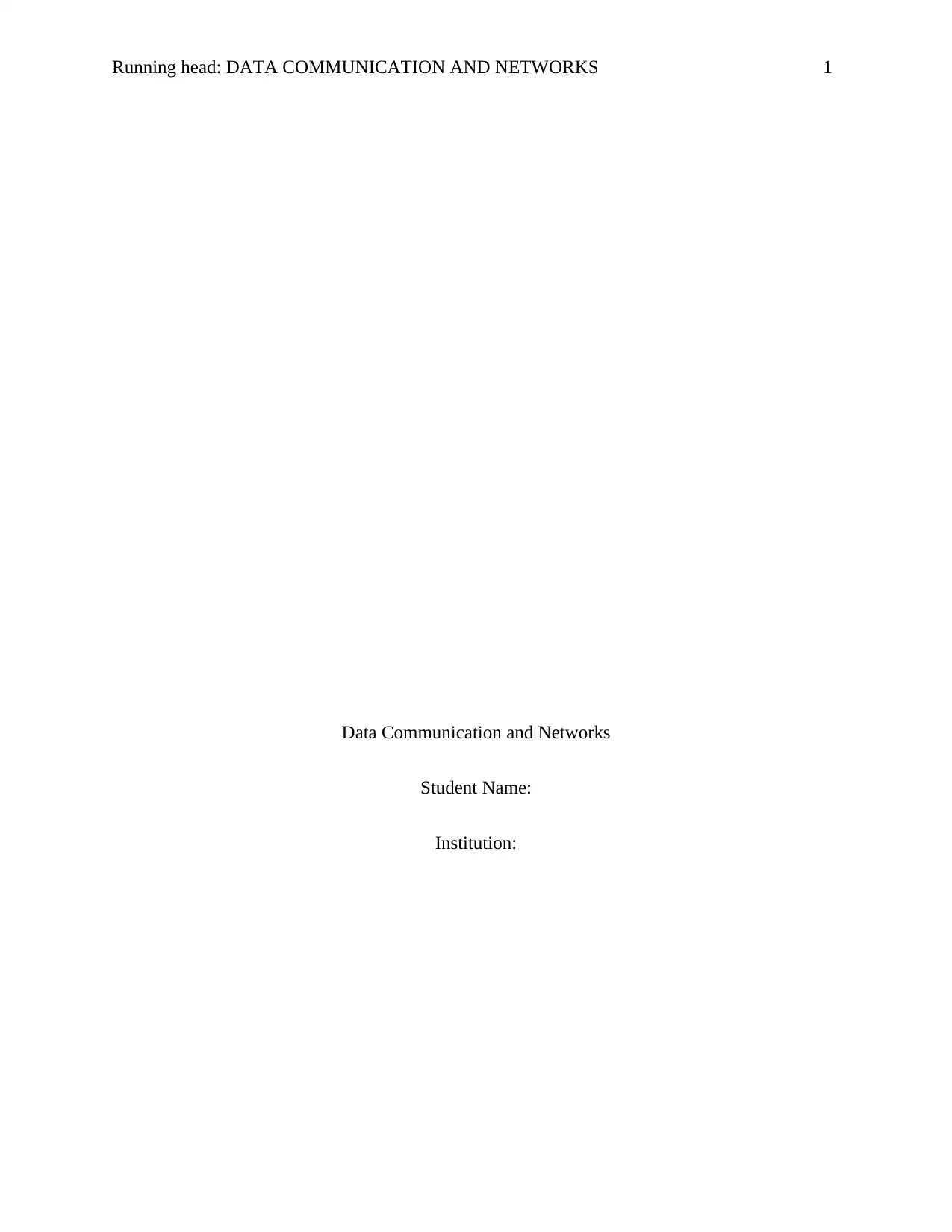
Running head: DATA COMMUNICATION AND NETWORKS 1
Data Communication and Networks
Student Name:
Institution:
Data Communication and Networks
Student Name:
Institution:
Secure Best Marks with AI Grader
Need help grading? Try our AI Grader for instant feedback on your assignments.
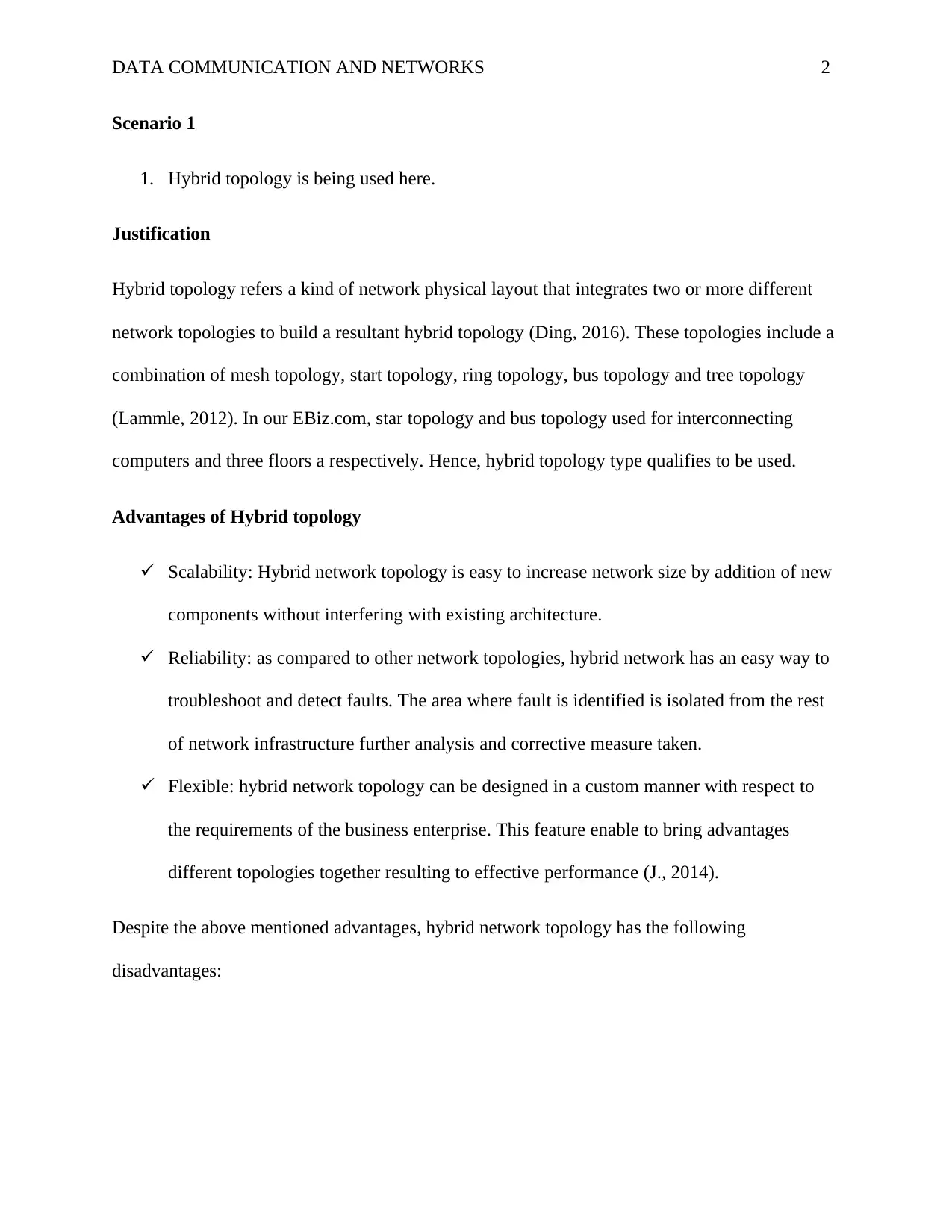
DATA COMMUNICATION AND NETWORKS 2
Scenario 1
1. Hybrid topology is being used here.
Justification
Hybrid topology refers a kind of network physical layout that integrates two or more different
network topologies to build a resultant hybrid topology (Ding, 2016). These topologies include a
combination of mesh topology, start topology, ring topology, bus topology and tree topology
(Lammle, 2012). In our EBiz.com, star topology and bus topology used for interconnecting
computers and three floors a respectively. Hence, hybrid topology type qualifies to be used.
Advantages of Hybrid topology
Scalability: Hybrid network topology is easy to increase network size by addition of new
components without interfering with existing architecture.
Reliability: as compared to other network topologies, hybrid network has an easy way to
troubleshoot and detect faults. The area where fault is identified is isolated from the rest
of network infrastructure further analysis and corrective measure taken.
Flexible: hybrid network topology can be designed in a custom manner with respect to
the requirements of the business enterprise. This feature enable to bring advantages
different topologies together resulting to effective performance (J., 2014).
Despite the above mentioned advantages, hybrid network topology has the following
disadvantages:
Scenario 1
1. Hybrid topology is being used here.
Justification
Hybrid topology refers a kind of network physical layout that integrates two or more different
network topologies to build a resultant hybrid topology (Ding, 2016). These topologies include a
combination of mesh topology, start topology, ring topology, bus topology and tree topology
(Lammle, 2012). In our EBiz.com, star topology and bus topology used for interconnecting
computers and three floors a respectively. Hence, hybrid topology type qualifies to be used.
Advantages of Hybrid topology
Scalability: Hybrid network topology is easy to increase network size by addition of new
components without interfering with existing architecture.
Reliability: as compared to other network topologies, hybrid network has an easy way to
troubleshoot and detect faults. The area where fault is identified is isolated from the rest
of network infrastructure further analysis and corrective measure taken.
Flexible: hybrid network topology can be designed in a custom manner with respect to
the requirements of the business enterprise. This feature enable to bring advantages
different topologies together resulting to effective performance (J., 2014).
Despite the above mentioned advantages, hybrid network topology has the following
disadvantages:
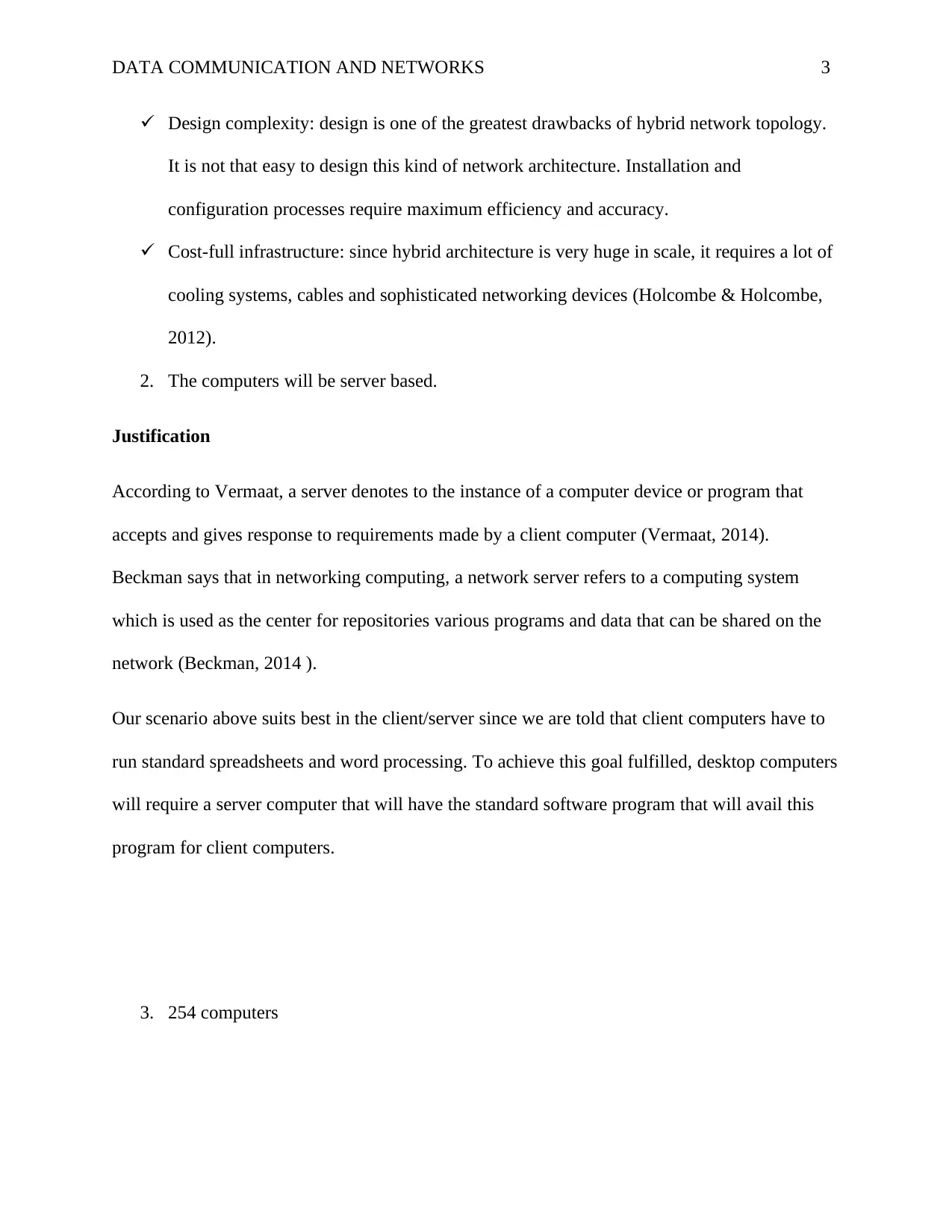
DATA COMMUNICATION AND NETWORKS 3
Design complexity: design is one of the greatest drawbacks of hybrid network topology.
It is not that easy to design this kind of network architecture. Installation and
configuration processes require maximum efficiency and accuracy.
Cost-full infrastructure: since hybrid architecture is very huge in scale, it requires a lot of
cooling systems, cables and sophisticated networking devices (Holcombe & Holcombe,
2012).
2. The computers will be server based.
Justification
According to Vermaat, a server denotes to the instance of a computer device or program that
accepts and gives response to requirements made by a client computer (Vermaat, 2014).
Beckman says that in networking computing, a network server refers to a computing system
which is used as the center for repositories various programs and data that can be shared on the
network (Beckman, 2014 ).
Our scenario above suits best in the client/server since we are told that client computers have to
run standard spreadsheets and word processing. To achieve this goal fulfilled, desktop computers
will require a server computer that will have the standard software program that will avail this
program for client computers.
3. 254 computers
Design complexity: design is one of the greatest drawbacks of hybrid network topology.
It is not that easy to design this kind of network architecture. Installation and
configuration processes require maximum efficiency and accuracy.
Cost-full infrastructure: since hybrid architecture is very huge in scale, it requires a lot of
cooling systems, cables and sophisticated networking devices (Holcombe & Holcombe,
2012).
2. The computers will be server based.
Justification
According to Vermaat, a server denotes to the instance of a computer device or program that
accepts and gives response to requirements made by a client computer (Vermaat, 2014).
Beckman says that in networking computing, a network server refers to a computing system
which is used as the center for repositories various programs and data that can be shared on the
network (Beckman, 2014 ).
Our scenario above suits best in the client/server since we are told that client computers have to
run standard spreadsheets and word processing. To achieve this goal fulfilled, desktop computers
will require a server computer that will have the standard software program that will avail this
program for client computers.
3. 254 computers
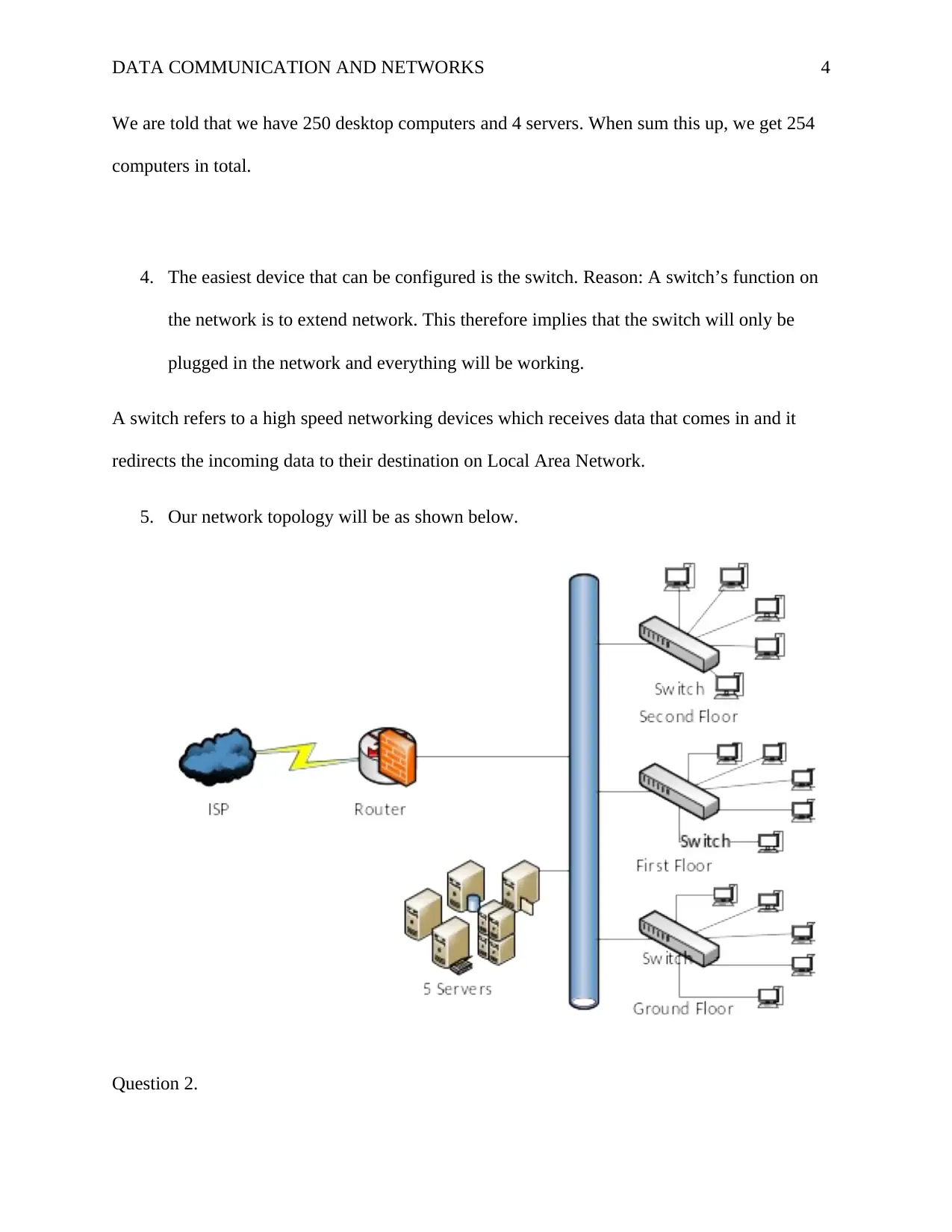
DATA COMMUNICATION AND NETWORKS 4
We are told that we have 250 desktop computers and 4 servers. When sum this up, we get 254
computers in total.
4. The easiest device that can be configured is the switch. Reason: A switch’s function on
the network is to extend network. This therefore implies that the switch will only be
plugged in the network and everything will be working.
A switch refers to a high speed networking devices which receives data that comes in and it
redirects the incoming data to their destination on Local Area Network.
5. Our network topology will be as shown below.
Question 2.
We are told that we have 250 desktop computers and 4 servers. When sum this up, we get 254
computers in total.
4. The easiest device that can be configured is the switch. Reason: A switch’s function on
the network is to extend network. This therefore implies that the switch will only be
plugged in the network and everything will be working.
A switch refers to a high speed networking devices which receives data that comes in and it
redirects the incoming data to their destination on Local Area Network.
5. Our network topology will be as shown below.
Question 2.
Secure Best Marks with AI Grader
Need help grading? Try our AI Grader for instant feedback on your assignments.
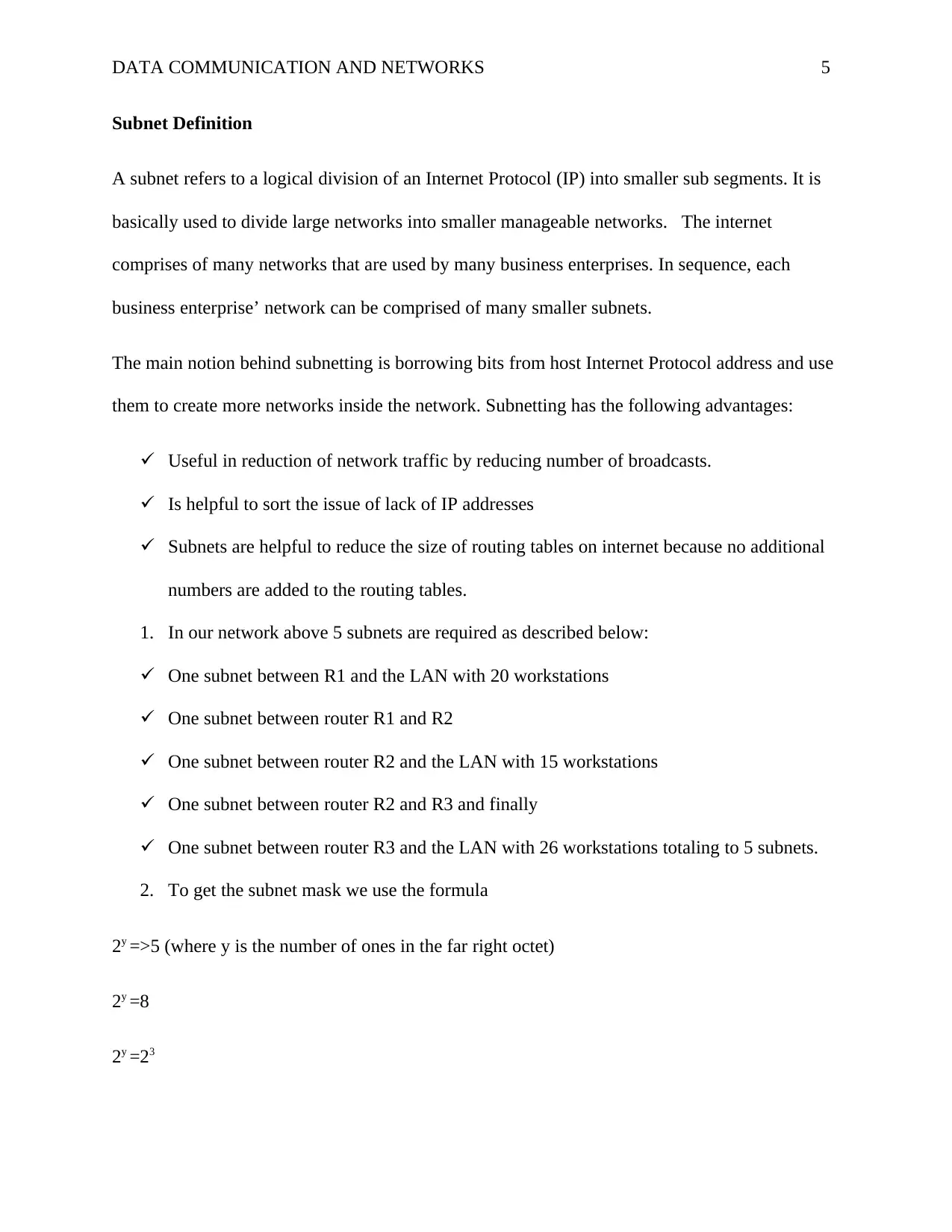
DATA COMMUNICATION AND NETWORKS 5
Subnet Definition
A subnet refers to a logical division of an Internet Protocol (IP) into smaller sub segments. It is
basically used to divide large networks into smaller manageable networks. The internet
comprises of many networks that are used by many business enterprises. In sequence, each
business enterprise’ network can be comprised of many smaller subnets.
The main notion behind subnetting is borrowing bits from host Internet Protocol address and use
them to create more networks inside the network. Subnetting has the following advantages:
Useful in reduction of network traffic by reducing number of broadcasts.
Is helpful to sort the issue of lack of IP addresses
Subnets are helpful to reduce the size of routing tables on internet because no additional
numbers are added to the routing tables.
1. In our network above 5 subnets are required as described below:
One subnet between R1 and the LAN with 20 workstations
One subnet between router R1 and R2
One subnet between router R2 and the LAN with 15 workstations
One subnet between router R2 and R3 and finally
One subnet between router R3 and the LAN with 26 workstations totaling to 5 subnets.
2. To get the subnet mask we use the formula
2y =>5 (where y is the number of ones in the far right octet)
2y =8
2y =23
Subnet Definition
A subnet refers to a logical division of an Internet Protocol (IP) into smaller sub segments. It is
basically used to divide large networks into smaller manageable networks. The internet
comprises of many networks that are used by many business enterprises. In sequence, each
business enterprise’ network can be comprised of many smaller subnets.
The main notion behind subnetting is borrowing bits from host Internet Protocol address and use
them to create more networks inside the network. Subnetting has the following advantages:
Useful in reduction of network traffic by reducing number of broadcasts.
Is helpful to sort the issue of lack of IP addresses
Subnets are helpful to reduce the size of routing tables on internet because no additional
numbers are added to the routing tables.
1. In our network above 5 subnets are required as described below:
One subnet between R1 and the LAN with 20 workstations
One subnet between router R1 and R2
One subnet between router R2 and the LAN with 15 workstations
One subnet between router R2 and R3 and finally
One subnet between router R3 and the LAN with 26 workstations totaling to 5 subnets.
2. To get the subnet mask we use the formula
2y =>5 (where y is the number of ones in the far right octet)
2y =8
2y =23
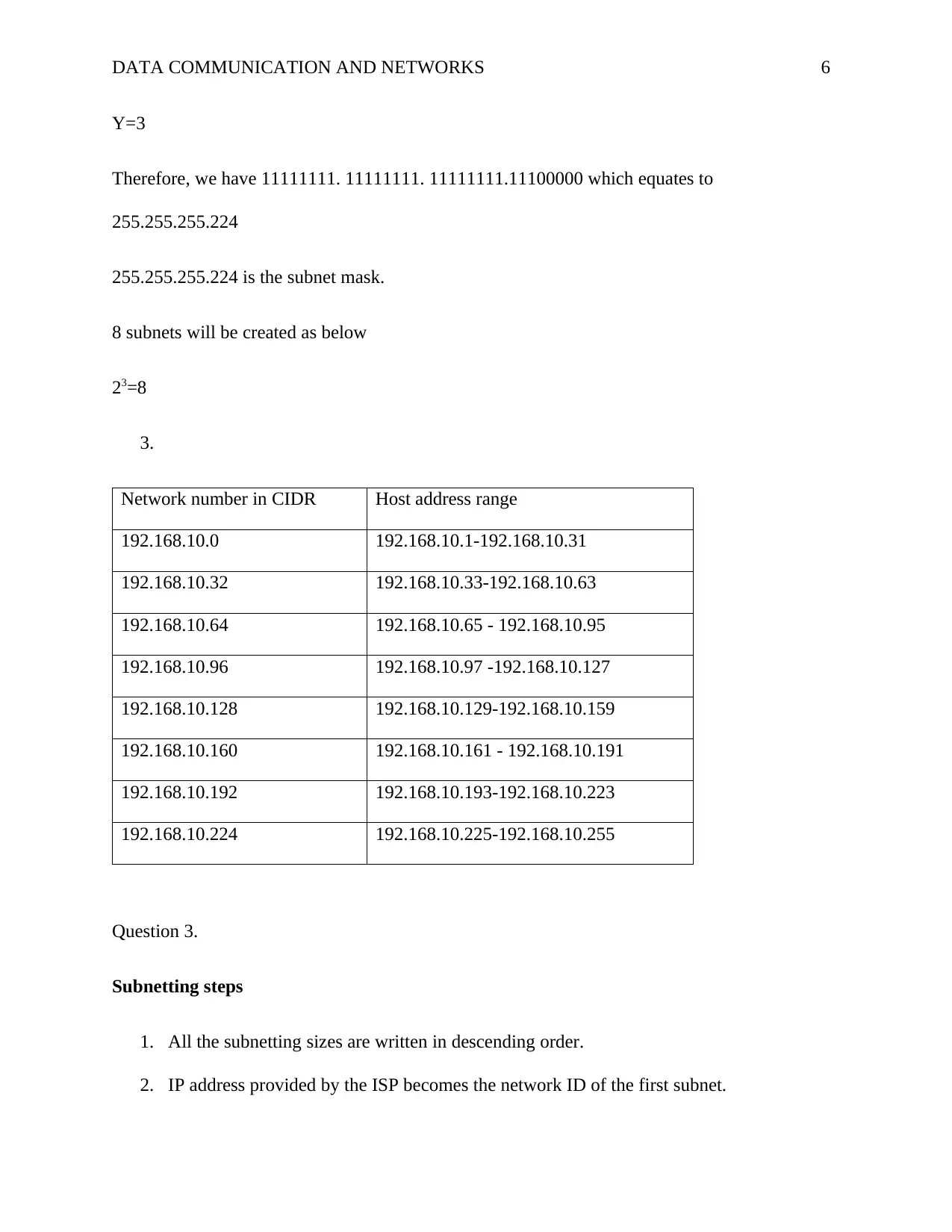
DATA COMMUNICATION AND NETWORKS 6
Y=3
Therefore, we have 11111111. 11111111. 11111111.11100000 which equates to
255.255.255.224
255.255.255.224 is the subnet mask.
8 subnets will be created as below
23=8
3.
Network number in CIDR Host address range
192.168.10.0 192.168.10.1-192.168.10.31
192.168.10.32 192.168.10.33-192.168.10.63
192.168.10.64 192.168.10.65 - 192.168.10.95
192.168.10.96 192.168.10.97 -192.168.10.127
192.168.10.128 192.168.10.129-192.168.10.159
192.168.10.160 192.168.10.161 - 192.168.10.191
192.168.10.192 192.168.10.193-192.168.10.223
192.168.10.224 192.168.10.225-192.168.10.255
Question 3.
Subnetting steps
1. All the subnetting sizes are written in descending order.
2. IP address provided by the ISP becomes the network ID of the first subnet.
Y=3
Therefore, we have 11111111. 11111111. 11111111.11100000 which equates to
255.255.255.224
255.255.255.224 is the subnet mask.
8 subnets will be created as below
23=8
3.
Network number in CIDR Host address range
192.168.10.0 192.168.10.1-192.168.10.31
192.168.10.32 192.168.10.33-192.168.10.63
192.168.10.64 192.168.10.65 - 192.168.10.95
192.168.10.96 192.168.10.97 -192.168.10.127
192.168.10.128 192.168.10.129-192.168.10.159
192.168.10.160 192.168.10.161 - 192.168.10.191
192.168.10.192 192.168.10.193-192.168.10.223
192.168.10.224 192.168.10.225-192.168.10.255
Question 3.
Subnetting steps
1. All the subnetting sizes are written in descending order.
2. IP address provided by the ISP becomes the network ID of the first subnet.
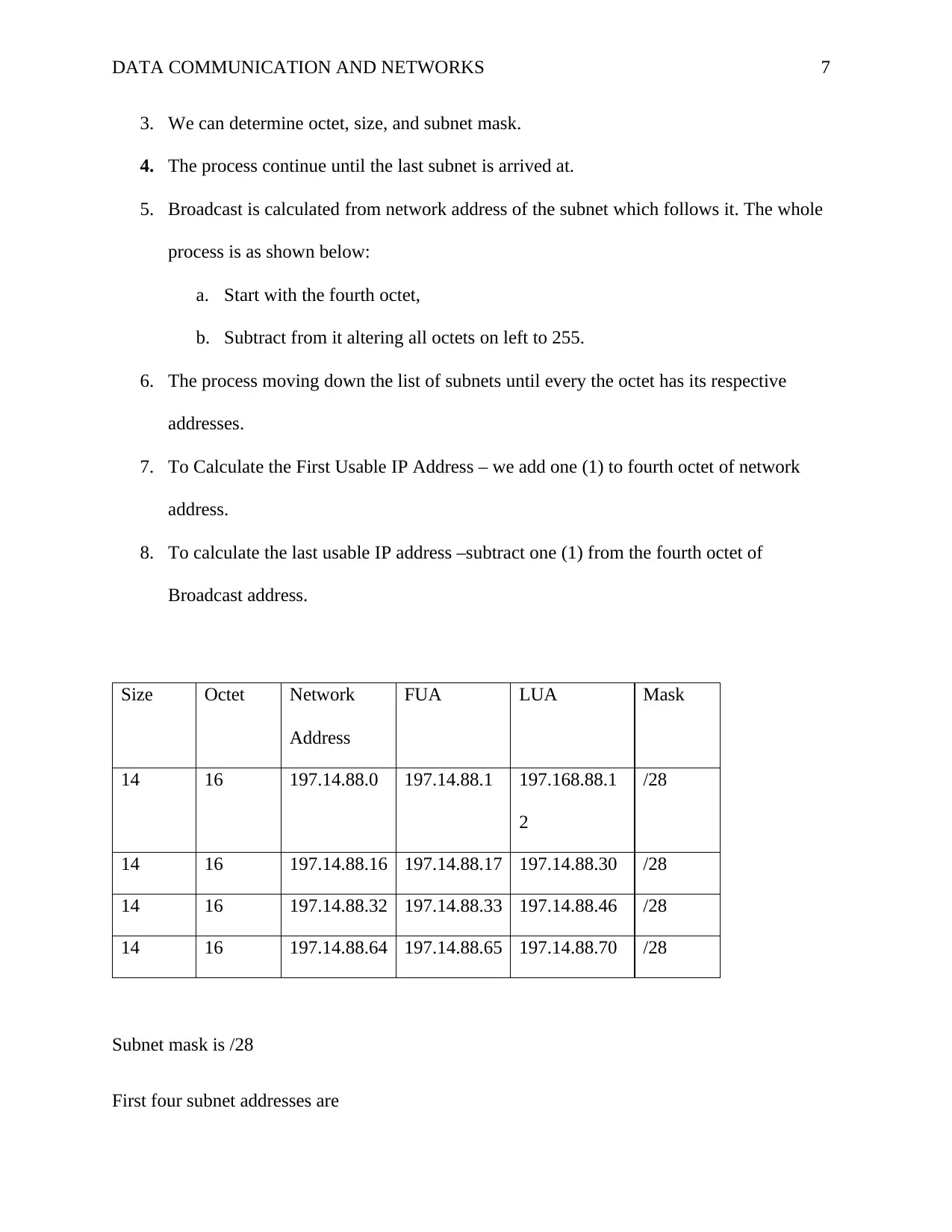
DATA COMMUNICATION AND NETWORKS 7
3. We can determine octet, size, and subnet mask.
4. The process continue until the last subnet is arrived at.
5. Broadcast is calculated from network address of the subnet which follows it. The whole
process is as shown below:
a. Start with the fourth octet,
b. Subtract from it altering all octets on left to 255.
6. The process moving down the list of subnets until every the octet has its respective
addresses.
7. To Calculate the First Usable IP Address – we add one (1) to fourth octet of network
address.
8. To calculate the last usable IP address –subtract one (1) from the fourth octet of
Broadcast address.
Size Octet Network
Address
FUA LUA Mask
14 16 197.14.88.0 197.14.88.1 197.168.88.1
2
/28
14 16 197.14.88.16 197.14.88.17 197.14.88.30 /28
14 16 197.14.88.32 197.14.88.33 197.14.88.46 /28
14 16 197.14.88.64 197.14.88.65 197.14.88.70 /28
Subnet mask is /28
First four subnet addresses are
3. We can determine octet, size, and subnet mask.
4. The process continue until the last subnet is arrived at.
5. Broadcast is calculated from network address of the subnet which follows it. The whole
process is as shown below:
a. Start with the fourth octet,
b. Subtract from it altering all octets on left to 255.
6. The process moving down the list of subnets until every the octet has its respective
addresses.
7. To Calculate the First Usable IP Address – we add one (1) to fourth octet of network
address.
8. To calculate the last usable IP address –subtract one (1) from the fourth octet of
Broadcast address.
Size Octet Network
Address
FUA LUA Mask
14 16 197.14.88.0 197.14.88.1 197.168.88.1
2
/28
14 16 197.14.88.16 197.14.88.17 197.14.88.30 /28
14 16 197.14.88.32 197.14.88.33 197.14.88.46 /28
14 16 197.14.88.64 197.14.88.65 197.14.88.70 /28
Subnet mask is /28
First four subnet addresses are
Paraphrase This Document
Need a fresh take? Get an instant paraphrase of this document with our AI Paraphraser

DATA COMMUNICATION AND NETWORKS 8
197.14.88.0
197.14.88.16
197.14.88.32
197.14.88.48
197.14.88.0
197.14.88.16
197.14.88.32
197.14.88.48
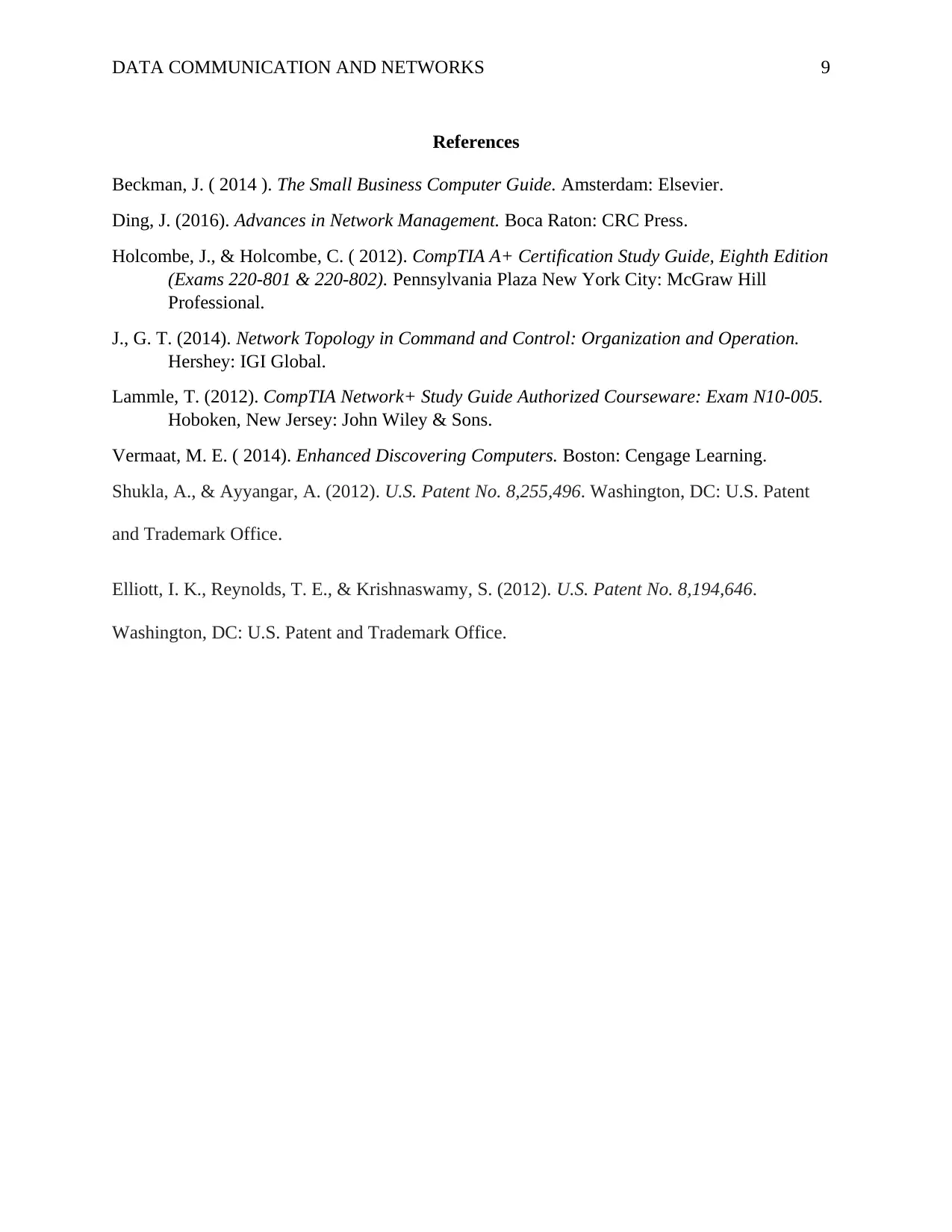
DATA COMMUNICATION AND NETWORKS 9
References
Beckman, J. ( 2014 ). The Small Business Computer Guide. Amsterdam: Elsevier.
Ding, J. (2016). Advances in Network Management. Boca Raton: CRC Press.
Holcombe, J., & Holcombe, C. ( 2012). CompTIA A+ Certification Study Guide, Eighth Edition
(Exams 220-801 & 220-802). Pennsylvania Plaza New York City: McGraw Hill
Professional.
J., G. T. (2014). Network Topology in Command and Control: Organization and Operation.
Hershey: IGI Global.
Lammle, T. (2012). CompTIA Network+ Study Guide Authorized Courseware: Exam N10-005.
Hoboken, New Jersey: John Wiley & Sons.
Vermaat, M. E. ( 2014). Enhanced Discovering Computers. Boston: Cengage Learning.
Shukla, A., & Ayyangar, A. (2012). U.S. Patent No. 8,255,496. Washington, DC: U.S. Patent
and Trademark Office.
Elliott, I. K., Reynolds, T. E., & Krishnaswamy, S. (2012). U.S. Patent No. 8,194,646.
Washington, DC: U.S. Patent and Trademark Office.
References
Beckman, J. ( 2014 ). The Small Business Computer Guide. Amsterdam: Elsevier.
Ding, J. (2016). Advances in Network Management. Boca Raton: CRC Press.
Holcombe, J., & Holcombe, C. ( 2012). CompTIA A+ Certification Study Guide, Eighth Edition
(Exams 220-801 & 220-802). Pennsylvania Plaza New York City: McGraw Hill
Professional.
J., G. T. (2014). Network Topology in Command and Control: Organization and Operation.
Hershey: IGI Global.
Lammle, T. (2012). CompTIA Network+ Study Guide Authorized Courseware: Exam N10-005.
Hoboken, New Jersey: John Wiley & Sons.
Vermaat, M. E. ( 2014). Enhanced Discovering Computers. Boston: Cengage Learning.
Shukla, A., & Ayyangar, A. (2012). U.S. Patent No. 8,255,496. Washington, DC: U.S. Patent
and Trademark Office.
Elliott, I. K., Reynolds, T. E., & Krishnaswamy, S. (2012). U.S. Patent No. 8,194,646.
Washington, DC: U.S. Patent and Trademark Office.
1 out of 9
Related Documents
Your All-in-One AI-Powered Toolkit for Academic Success.
+13062052269
info@desklib.com
Available 24*7 on WhatsApp / Email
![[object Object]](/_next/static/media/star-bottom.7253800d.svg)
Unlock your academic potential
© 2024 | Zucol Services PVT LTD | All rights reserved.




